COVID-19 and India’s migrant conundrum
The World Migration Report 2020 states that the number of international migrants is estimated to be almost 272 million globally, with nearly two-thirds (164 million) of them being labour migrants. These migrants have played a major role in not only the places where they landed (by contributing taxes) but also to their countries of origin (by sending back remittances).
However, the onset of COVID-19 is forcing a significant number of migrants to return to their home countries along with a contraction in the remittances sent home. This is particularly a tough situation for India, which has the largest diaspora in the world and receives the highest remittances.

Since the earliest times, human beings have been on the move for numerous reasons – in search of work or economic opportunities, to join family, to study, to escape conflict, persecution, terrorism, or human rights violations. According to the UN Migration Agency (IOM), a migrant is any person who is moving or has moved across an international border or within a State away from his/her habitual place of residence, regardless of (1) the person’s legal status; (2) whether the movement is voluntary or involuntary; (3) what the causes for the movement are; or (4) what the length of the stay is.
Global migration trends
Over the last few years, the world has been on the move like never before. The World Migration Report 2020 states that the number of international migrants is estimated to be almost 272 million globally, with nearly two-thirds (164 million) of them being labour migrants. Economists say that these migrants have played a major role in not only the places where they landed (by contributing taxes) but also to their countries of origin (by sending back home remittances).
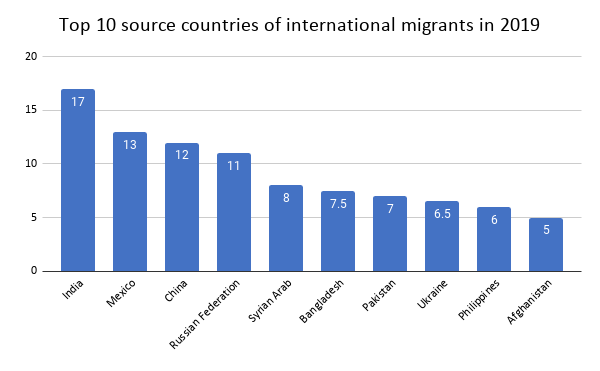
Source: World Migration Report, 2020. All figures are in million.
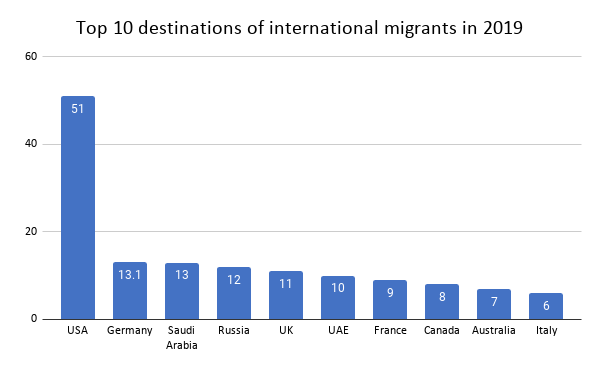
Source: World Migration Report, 2020. All figures are in million.
The above graphs indicate the top 10 countries of origin & destination for international migrants in 2019. Over 40% of all international migrants worldwide in 2019 (112 million) were born in Asia, with India accounting for the highest number of international migrants. Other Asian economies like China, Bangladesh, Pakistan and Afghanistan, too, contributed significantly to this international outmigration. Mexico emerged as the second largest country of origin, while the Russian Federation was fourth.
Meanwhile, the United States of America has been the main country of destination for international migrants, with their population quadrupling from less than 12 million in 1970 to close to 51 million in 2019. Germany, Saudi Arabia, Russian Federation, United Arab Emirates and United Kingdom were among the other top countries to attract international migrants in 2019. It is interesting to note that several European countries have sizable populations of emigrants. When it comes to the distribution of international migrants by countries’ income group, most of them tended to gravitate toward high-income countries in 2019 (around 176 million), as against middle-income countries (approx. 82 million) and low-income countries (about 13 million).
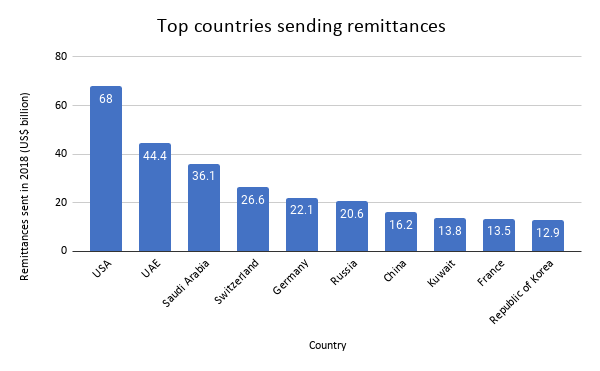
Source: International Organization for Migration, 2020. All figures are in US$ billion.
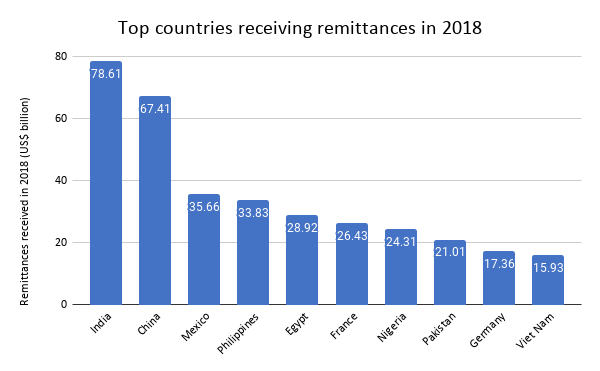
Source: World Migration Report, 2020. All figures are in US$ billion.
There was a 9% increase in remittances in 2018 to US$ 689 billion, up from US$ 633 billion in 2017. Remittances are financial or in-kind transfers made by migrants directly to families or communities in their countries of origin. These money transfers from citizens working abroad, don’t just support their families, but also provide a lifeline for development in many developing and less developed countries.
These international transfers of wealth are used to increase national savings, diminish constraints associated with foreign exchange and balance of payments, and contribute to development budget in the migrants’ home countries. Therefore, they’re also an important weapon in reduction and eradication of poverty. Studies show that they also serve as a key mechanism for boosting consumption in a migrant worker’s home country.
Since most of the international migrants prefer to settle in high-income countries, these emerge as the main sources of remittances. Not surprisingly, the USA has consistently been the top remittance-sending country, with a total outflow of US$ 67.96 billion in 2018. The United Arab Emirates, Saudi and Switzerland are other top source countries for remittances.
In 2018, India, China, Mexico, the Philippines and Egypt were the top remittance recipient countries, albeit when remittances are viewed as a percentage of gross domestic product, Tonga (35.2%), Kyrgyzstan (33.6%), Tajikistan (31%), Haiti (30.7%) and Nepal (28%) take the lead.
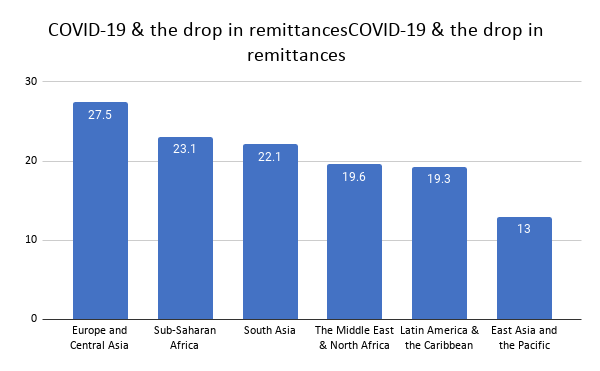
Source: World Bank. All figures are in percentage.
The World Bank predicts that global remittances are projected to decline sharply by about 20% in 2020, the sharpest decline in recent history. This has been attributed to a fall in the wages and employment of migrant workers due to the economic crisis induced by the COVID-19 pandemic and shutdown. Migrant workers tend to be more vulnerable to loss of employment and wages during an economic crisis in a host country. Moreover, a number of them are moving back to their home countries for fear of lives and livelihoods. In India itself, it is projected that around 3 million emigrants will return home by December 2020, out of which around 0.5-1 million will be distressed migrants.
Remittance flows are expected to fall notably in Europe and Central Asia (27.5%). However, other regions too will take a hit: Sub-Saharan Africa, South Asia, the Middle East and North Africa, Latin America and the Caribbean and East Asia and the Pacific. The bank expects remittances to low and middle-income countries (LMICs) to fall by 19.7% to US$ 445 billion. Noting this unfavorable development, World Bank Group President David Malpass said:
“Remittances are a vital source of income for developing countries. The ongoing economic recession caused by COVID-19 is taking a severe toll on the ability to send money home and makes it all the more vital that we shorten the time to recovery for advanced economies.”
A closer look home
According to the UN’s International Migrant Stock 2019, brought out by the International Organization for Migration, India has the largest diaspora in the world. It has around 17.5 million of its citizens living in other countries and comprises 6.4% of the total global migrant population. The UAE, US, Saudi Arabia, Pakistan and Oman are the most popular choices for Indian emigrants to move to.
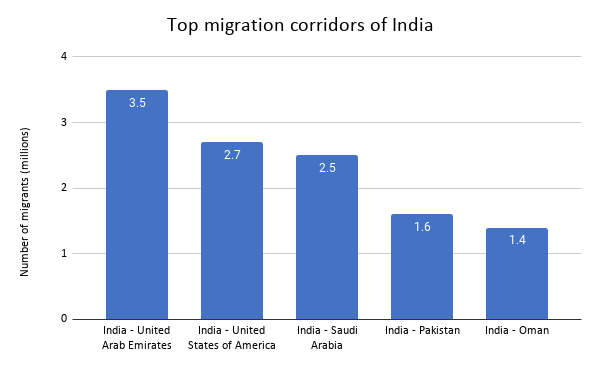
Source: World Migration Report 2020; all figures are in million.
India is also the highest recipient of remittances in the world, according to the World Bank. Over the last three years, India has registered a significant flow of remittances, growing from US$ 62.7 billion in 2016 to US$ 79 billion in 2018. “The upsurge was driven by stronger economic conditions in the United States and a pick-up in oil prices, which had a positive impact on outward remittances from some GCC countries,” the bank said.
However, COVID-19 has significantly compromised on the ability of migrants to send remittances home. The Asian Development Bank, in its August 2020 brief titled ‘COVID-19: Impact on International Migration, Remittances, and Recipient Households in Developing Asia’, recently predicted that India will be one of the most severely impacted regions to see remittances plunge. The World Bank also states that remittances to India are likely to drop by 23% in 2020 from US$ 83 billion last year to US$ 64 billion, owing to the economic distress induced by the Coronavirus.
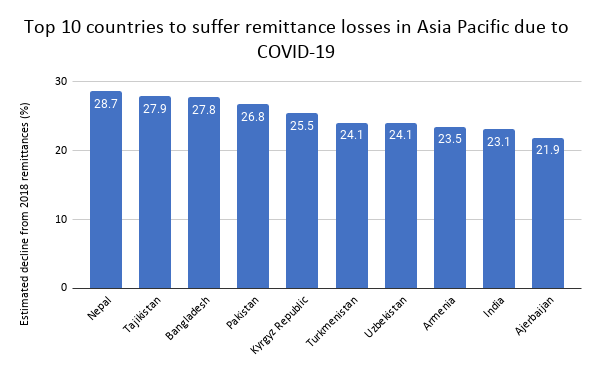
Source: Asian Development Bank
What has added to the woes of India, is the return of Indian emigrants due to COVID-19. According to sources, India’s repatriation operation is set to return 200,000 migrant workers from around the world. Professor S Irudaya Rajan, Centre for Development Studies, opines:
Approximately 15 lakh people will come back from the Gulf and 15 lakh will come from other parts of the world like London, US, Germany, China, etc. Thus, we are expecting 30 lakh Indians to return; while Vande Bharat flights brought back only 10 lakh Indian emigrants.
A similar trend is being observed in other parts of the world. Over 230,000 undocumented Afghans came back from Iran and Pakistan between 1 March 2020 and 30 May 2020 (IOM, 2020). Of the 4.3 million Venezuelan migrants and refugees in countries in Latin America and Caribbean, a growing number are attempting to return to Venezuela from Peru and other countries in the region (Response for Venezuelans, 2020).
Countries across the world have started talking about visa restrictions and are shutting their borders to ‘outsiders’. For example, Kuwait’s National Assembly has approved the draft expat quota bill, according to which Indians should not surpass 15% of the population. This may force around 800,000 Indians to leave Kuwait, a nation with a population of 4.3 million people, with 3 million of them being expats. The Indian community is estimated to constitute the largest expat community in Kuwait, aggregating 1.45 million.
Such exoduses of migrant workers have consequences both for countries of destination & origin. While the former face the challenge of paucity of labour force, the latter lose remittances and are faced with the problem of re-integrating the returnees into the society and economy. India, owing to the fact that it belongs to the latter category, is facing exactly this challenge. It is important to examine thoroughly the reasons for return migration and reduction in remittances flow and have country specific strategies.
A multi-pronged strategy would be required to resolve this issue, which could entail investments in human capital and upskilling, revival of productive sectors, programs to stimulate entrepreneurship and exploring options for re-migration. This will not only engage those returning to their motherland from foreign countries, it will also enable India to make effective use of the strengths of its diaspora in its quest to revive economic growth.













Leave a comment